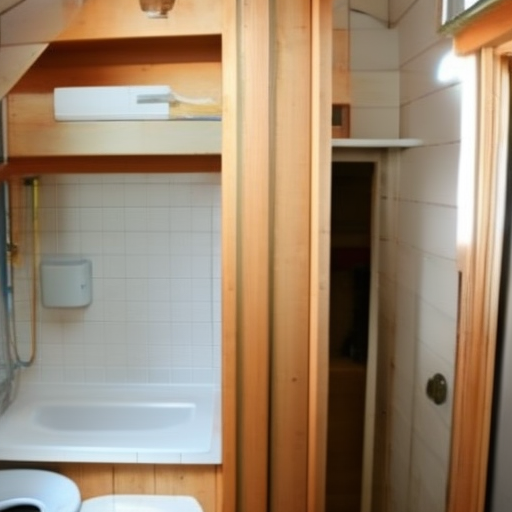Living in a tiny house can bring a feeling of freedom, of cutting unnecessary baggage and clutter away. What, however, if it comes with the baggage of complicated plumbing solutions? In this article, we explore the possibilities of compact and sophisticated solutions that make plumbing a breeze in your tiny house.

Achieving Adequate Plumbing
Imagine waking up one day and your toilet won’t flush. Or your showerhead emits an annoying trickle instead of a pleasant stream of hot water. It’s frustrating to have to deal with plumbing issues on a regular basis, and more often than not, it’s not something you can easily fix yourself.
But fear not! With a little bit of knowledge and maintenance, you can achieve adequate plumbing that works effectively and efficiently. Here are some tips:
- Regularly inspect your pipes: Check for leaks, damage or corrosion in your pipes. Early detection can prevent a small problem from turning into a major headache.
- Be mindful of what goes down your drains: Avoid pouring oil, grease, coffee grounds, and other non-degradable items down the drain. This can lead to clogs and pollute the environment.
- Install water-saving fixtures: Opt for low-flow showerheads, faucets, and toilets. Not only will you conserve water, but you’ll also save money on your water bill.
By taking these small steps, you can avoid costly plumbing repairs and ensure that your home runs smoothly. Remember, adequate plumbing is a key element in maintaining a comfortable and functional home.
Space-Saving Plumbing Alternatives
Imagine you’re moving into a tiny house or an urban condo with limited space for all your belongings, including the plumbing fixtures. Where would you fit a standard bathtub or a four-piece bathroom suite? Fortunately, you don’t have to sacrifice comfort, convenience, or style that can help you maximize your living area without compromising your quality of life.
One option is to install a corner shower that takes up less room than a traditional unit but still provides enough space for showering. You can choose from various shapes, sizes, and styles that suit your needs and preferences, such as a curved or rectangular design, a sliding or swinging door, or a frameless or framed enclosure. Some corner showers come with built-in shelves or benches, which can save you more space by eliminating the need for separate storage or seating units. Another advantage of a corner shower is that it can make your bathroom look more spacious by creating an open corner that can enhance the flow and the lighting of the room.
Considerations for Plumbing Systems in Tiny Houses
Size Matters! When it comes to tiny houses, the size of the plumbing system is a major consideration. In a tiny house, every square inch of space is valuable real estate, so it’s important to think small when it comes to plumbing. Consider using flexible PEX tubing instead of rigid copper piping, which takes up more space. You can also use a compact tankless water heater to save space and reduce energy consumption.
Going Off-Grid Many tiny homeowners are looking to live off-grid, which means they’ll need a plumbing system that is self-sufficient. Greywater systems, which reuse water from showers and sinks to flush toilets or water plants, are a popular choice for off-grid tiny homes. Composting toilets are also common among tiny homeowners because they don’t require a traditional septic system. If you’re planning to use a traditional toilet, consider a low-flow model to conserve water. And don’t forget to insulate your pipes to prevent freezing in colder climates. When it comes to plumbing in tiny homes, every decision you make can have a big impact on your quality of life, so choose wisely!
Solutions for Sanitation, Water, and Sewerage Problems
Living without proper sanitation facilities, safe water, and sewerage can have serious consequences on people’s lives. These issues can lead to the spread of diseases, malnutrition, poverty, and even loss of life. Developing countries often struggle with these problems due to a lack of resources, ineffective management, and inadequate infrastructure. However, there are various solutions available to help overcome these challenges.
One effective solution is to build community-based water and sanitation projects. These projects involve local participation and ownership and provide clean water sources, sanitation facilities, and sewerage systems. For instance, in rural areas of Ghana, communities have successfully implemented water projects, such as hand-dug wells and boreholes, to provide safe drinking water. Additionally, initiatives like the “Community-Led Total Sanitation” program have encouraged people to build their own toilets and maintain hygiene standards. This has greatly improved the overall health and well-being of the community. By prioritizing community-led solutions that are low-cost, it’s possible to tackle water, sanitation, and sewerage issues in a sustainable and effective way.
Tiny house plumbing might seem like a tricky thing to tackle, but with a bit of knowledge and a lot of creativity, it’s totally possible to craft a cozy and efficient wet system that works well and looks good. Small talk doesn’t have to mean limited options; with thoughtful planning, even the tiniest spaces can become a luxurious places to call home.